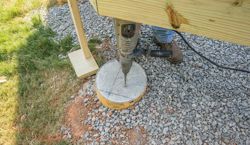Strong Foundations, Gorgeous Decks: The Ultimate Overview to Deck Footings
Wiki Article
Important Tips for Solid Deck Footing: A Comprehensive Guide
Building a deck is an investment that calls for mindful preparation and interest to information, specifically when it comes to the footing. This overview will cover vital facets such as selecting the right materials, evaluating soil problems, determining lots capacity, establishing correct ground depth, and attaining precise installation. Let's dive into the globe of solid deck ground and develop a structure you can rely on.Picking the Right Deck Footing Products
When choosing the appropriate deck footing materials, it is essential to think about the certain needs and requirements of your job. The quality and sturdiness of the footings directly impact the security and long life of the deck structure. When selecting deck ground products., there are numerous variables to take into consideration.One essential consideration is the type of soil in your area. Different dirt kinds have differing load-bearing abilities and drain properties. As an example, clay soils often tend to preserve water, while sandy dirts drain swiftly. Comprehending your soil conditions will certainly assist you choose grounds that can properly sustain the weight of the deck and avoid concerns such as sinking or heaving.
Extreme temperatures, dampness degrees, and freeze-thaw cycles can affect the performance of deck grounds. In such cases, utilizing frost-resistant products or setting up footings below the frost line can aid mitigate these threats.
In addition, the dimension and layout of your deck must also affect your option of footing materials. Larger or more intricate decks may call for deeper or enhanced footings to guarantee sufficient assistance. Understanding the details lots demands of your deck will certainly assist you figure out the proper materials to make use of.
Ultimately, choosing the appropriate deck ground products entails cautious factor to consider of aspects such as soil problems, climate, and deck design. By taking these elements into account, you can pick footings that give the required support, improve the security of your deck, and ensure its long life.
Properly Examining Dirt Conditions
To effectively assess soil conditions for your deck ground, it is crucial to extensively analyze the load-bearing abilities and water drainage residential properties of the dirt in your area. Recognizing the dirt's ability to birth weight and its ability to drain pipes excess water will help guarantee the security and longevity of your deck.When analyzing the load-bearing capability of the soil, it is vital to consider elements such as dirt type, thickness, and compaction. Various dirt types have differing load-bearing capabilities, with compacted soils generally using much better assistance than loose or sandy dirts. Conducting a soil examination can give useful info concerning the soil's capability to support the weight of your deck.
Additionally, assessing the drain residential properties of the soil is important to prevent water buildup and possible damages to your deck - Deck Footings. Poor drain can cause moisture build-up, which can deteriorate the structure and cause architectural problems. It is necessary to evaluate the soil's capability to drain water effectively to prevent these troubles
Consulting with an expert engineer or dirt specialist can significantly aid in effectively assessing dirt conditions for your deck footing. They can offer experienced suggestions and support, making sure that you pick the proper footing layout and materials based upon the particular features of the soil in your location. Making the effort to thoroughly examine soil conditions will help you construct a strong and durable deck.
Calculating Lots Ability for Footings
One important action in making certain the stability of your deck is to accurately calculate the load capacity for your grounds. Deck Footings. The tons ability describes the optimum amount of weight or load that the footings can safely support without creating any kind of structural damage or failing. Determining the load capacity for footings entails taking into consideration different aspects such as the size and type of footings, the type of soil, the measurements and weight of the deck, and the online tons and dead load that the deck will go throughTo compute the lots ability, it is essential to seek advice from local structure codes and policies as they give certain guidelines and demands for deck building. These codes consider variables such as soil bearing capability, frost deepness, and minimum footing measurements. Furthermore, it is crucial to engage the solutions of an architectural engineer or an expert specialist that can carry out the necessary estimations and assessments to make sure the safety and stability of the deck.
When computing the tons capacity, it is vital to accurately figure out the live load and dead tons that the deck will certainly experience. The online load describes the weight of people, furnishings, and any kind of other items that will certainly be placed on the deck, while the dead load refers to the weight of the deck itself. By accurately establishing these lots and taking into consideration all pertinent aspects, you can make sure that your footings are adequately developed to support the weight and preserve the security of your deck.
Making Certain Proper Ground Deepness
Appropriate footing deepness is essential for making sure the stability and long life of your deck. The deepness at which the footings are set up straight impacts the structural integrity of the my website deck, as it determines exactly how well the grounds can stand up to the pressures put in by the deck and the soil under it.When determining the suitable footing depth, numerous variables have to be thought about. In locations with expansive clay soil, much deeper footings might be required to give adequate assistance.
To identify the appropriate ground deepness, it is recommended to speak with an architectural engineer or structure assessor that can assess the details conditions of your website and supply advice based upon local building regulations and regulations. They will certainly take into consideration factors such as dirt structure, aquifer level, and expected lots to identify the minimum required ground deepness.
Mounting Grounds With Accuracy
Mounting grounds with precision is important for guaranteeing the stability and structural honesty of your deck. Appropriately mounted footings provide a strong structure, guaranteeing that your deck can endure the weight of furniture, people, and other lots. To install footings with accuracy, there are several key actions to adhere to.First of all, it is crucial to accurately note the place of each ground. This can be done by making use of a string or chalk line to develop a clear overview. By determining and marking the precise placements, you can guarantee that the grounds are evenly spaced and aligned.
Next, you need to dig the openings for the grounds. It is critical to dig them to the proper Discover More Here deepness and diameter, as specified by local structure codes and guidelines. This will certainly provide adequate support and avoid the deck from sinking or shifting in time.
Once the openings are dug, it is very important to degree and small the dirt at the bottom of each opening. This will certainly create a stable base for the footing to rest on and prevent any settling or motion.
After preparing the holes, you can proceed with putting the concrete. Use a concrete mix that is suitable for footings and adhere to the manufacturer's guidelines for pouring and mixing. Guarantee that the concrete fills the holes entirely and is level with the ground surface area.
Last but not least, allow the concrete to cure properly prior to waging the construction of your deck. This will guarantee that the footings are secure and solid, offering a protected structure for your deck.

Verdict
Finally, ensuring strong deck footing is important for the stability and long life of a deck structure. By selecting the proper ground products, analyzing soil problems, computing tons capacity, and installing footings with accuracy, the threat of structural failing can be decreased. Following these crucial suggestions will certainly help create a solid foundation for any deck job.Understanding your soil problems will help you pick footings that can properly support the weight of the deck and avoid concerns such as sinking or heaving.
Consulting with a professional engineer or soil professional can considerably aid in appropriately assessing dirt conditions click reference for your deck ground. Calculating the lots capacity for footings involves thinking about numerous aspects such as the size and kind of footings, the type of dirt, the dimensions and weight of the deck, and the live tons and dead lots that the deck will be subjected to.

Report this wiki page